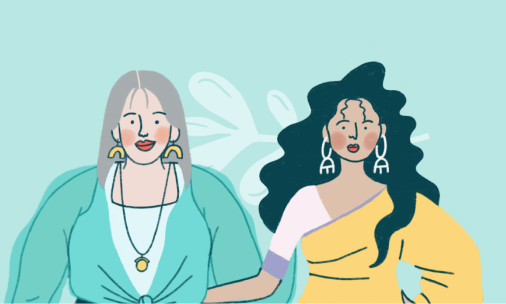Hair loss: are perimenopause and menopause to blame?
How to tackle thinning hair and restore hair health
- Hair can be vital to your self-esteem and confidence
- Hair shedding can be gradual or sudden
- Not all hair loss is hormone related – genetics and health play a part
By the time you reach perimenopause or menopause, you’ve most likely been bombarded with images of women shaking out their thick, lustrous hair. What we don’t see is strands coming out, yet it’s normal to lose between 50 and 100 hairs a day. But if you’ve started to notice you’re losing more hair than usual, it can be hard to determine the cause – and the solution.
Who is affected by hair loss?
Hair follicles start to shrink from your mid-40s, so hair becomes thinner with age. The number of hair follicles also reduces. Hair loss may start during the perimenopause or occur many years after. In a Newson Health poll of nearly 6,000 women, 50% of respondents said they’d noticed their hair was thinning and 39% experienced hair loss [1].
You’ll probably notice your hair thinning or shedding before anyone else does. You’ll be used to knowing how much hair you usually lose when brushing or showering, and how it normally feels in your fingers. You might notice you’re gradually losing more hair than usual or that your hair line is moving backwards, or the parting widening, or you might notice your scalp more, especially when your hair is wet.
RELATED: Dry, brittle hair and the menopause
Can perimenopause and menopause cause hair loss?
While hair thinning and shedding can be a natural part of ageing, there can be numerous factors involved. One of these is menopause. There are hormone receptors in the hair follicles and when levels of oestradiol, progesterone and testosterone drop, it can lead to shedding and hair loss.
For women who experience hair loss during perimenopause and menopause, roughly two thirds will have a general loss of hair over their scalp [2] and most of those women will also experience thinning of hair on the body. This can be due to loss of any of the three hormones as they all affect hair growth in different ways [3].
The other third of women who experience hair loss in menopause will have it localised to the frontal area of their scalp and may have additional hair where they don’t want it, such as the upper lip or chin. This can be related to an imbalance of the hormones that often occurs [4].
RELATED: Hair loss and hormones: Dr Sajjad Rajpar
What else can cause hair loss?
There are other causes of hair loss and more than one of them could be responsible. They can include:
Female pattern hair loss This is often hereditary – in many cases genetics, rather than menopause, can be the cause.
Telogen effluvium This is a type of temporary hair loss that can occur as a result of severe stress, an illness, calorie restriction, thyroid hormone imbalance or iron deficiency. The hair’s growth cycle becomes imbalanced, and hair can intensely shed.
Skin conditions Seborrheic dermatitis (dandruff) and scalp disorders can cause hair loss, as can alopecia areata, lupus and scarring alopecia.
Medications Certain drugs can cause hair to shed such as pain killers, antidepressants and some blood pressure treatments.
RELATED: Skin, hair and nail changes in menopause: a dermatologist’s guide
What treatments can I try?
Before determining a treatment plan, you should consult a hair loss specialist to try to determine the cause or causes of your hair loss so you can tailor your plan and treatment to your needs.
Minodixil is the only medication that’s licensed for the treatment of hair loss in women – it’s only licensed for female pattern hair loss but can help other hair loss conditions. You don’t need a prescription but should discuss the pros and cons of taking it with your doctor.
Medications that may boost hair growth in women and are prescribed in hair tonics or in oral from by some healthcare practitioners include higher strengths of minoxidil, finasteride, cyproterone, caffeine and tretinoin. Bespoke combinations are usually prescribed for each patient and can help target the predominant cause. It is important to note these medications are not licensed for hair loss in women and you should discuss the risks and benefits with an experienced practitioner before embarking on these treatments.
Many women find that when they are taking the right dose and type of natural body identical hormones, their hair loss reduces and their hair growth improves. Testosterone (at the right individual dose) can improve hair growth in many women who also notice that it helps it grow thicker.
RELATED: Testosterone and hair during the menopause
Many hair supplements are on the market but while the likes of zinc, biotin and iron contribute towards hair growth, supplements should only be taken if levels are low following testing, and under supervision.
How else can I look after my hair?
Use a gentle shampoo – consider an anti-dandruff shampoo if you have any scaling – and a good quality conditioner. Avoid tight hair styles to reduce the strain on hair follicles and avoid intense hair drying or heated appliances, which can damage hair shafts and make them more prone to splitting. Also protect your scalp from the sun’s damaging ultra violet (UV) rays by wearing a hat.
Ensure you eat a balanced diet and if you’re planning to lose weight, do so very gradually – sudden drops in calorie intake can affect your hair. Managing stress can be beneficial to your hair’s health, and a hairdresser can help with volume-boosting style or suggest root sprays to conceal loss. Finally, remember that you’ll need to be patient to see an effect from any positive changes you make – typically three to six months.
References
1.Randall V.A., Hibberts N.A., Thornton M.J., Hamada K., Merrick A.E., Kato S., Jenner T.J., De Oliveira I., Messenger A.G. (2000), ‘The hair follicle: a paradoxical androgen target organ’, Horm Res. 54(5-6):243-50. doi: 10.1159/000053266
2. Newson Health (2022), Women’s Experiences of the Perimenopause and Menopause
3. Ali I., Wojnarowska F. (2011), ‘Physiological changes in scalp, facial and body hair after the menopause: a cross-sectional population-based study of subjective changes’, Br J Dermatol, 164(3):508-13. doi: 10.1111/j.1365-2133.2010.10156.x
4. Grymowicz M., Rudnicka E., Podfigurna A., Napierala P., Smolarczyk R., Smolarczyk K., Meczekalski B. (2020), ‘Hormonal Effects on Hair Follicles’, Int J Mol Sci, 21(15) pp5342. doi: 10.3390/ijms21155342





